Capturing Gen Z Attention: Top Trends Marketers Need to Know in 2024
PUBLISH DATE: 22 February 2024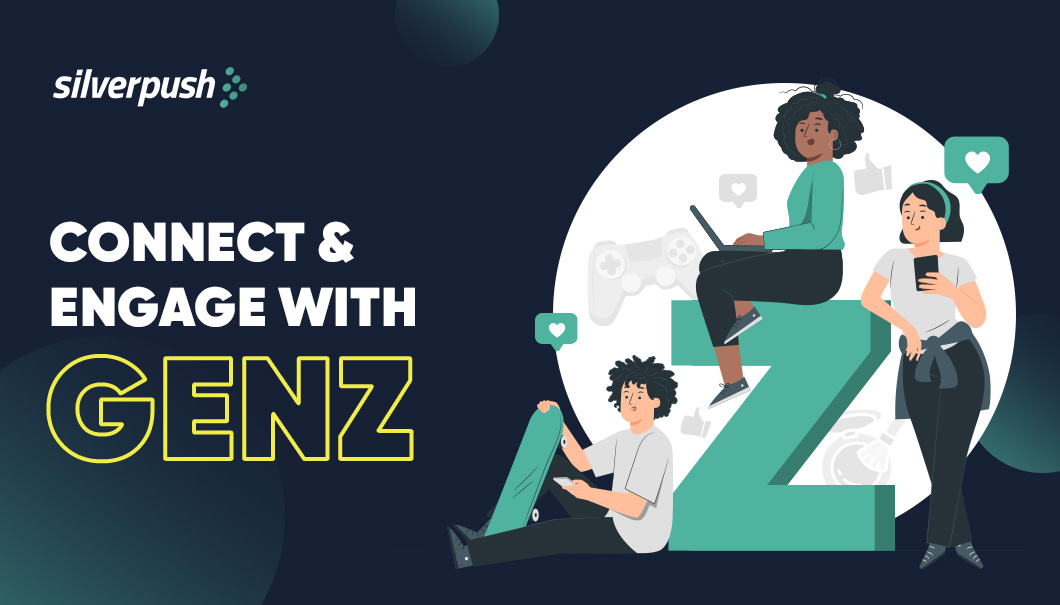
Step aside, millennials; a fresh generation is in town – Gen Z has taken the spotlight. Born between 1997 and 2012, these digital natives are rewriting the rules of everything, from fashion to politics, and most importantly, how they consume information. For Gen Z, the search engine is now a TikTok, a YouTube tutorial, or even a casual browse through Amazon. This seismic shift in behavior presents a golden opportunity for savvy brands.
With an estimated spending power of $360 billion & an increasing influence (41 million GenZers shall be eligible to vote in 2024 US elections. Their influence extends beyond consumer choices to shaping the political landscape. As the torchbearers of the future, Gen Z demands a nuanced approach – one that not only caters to their preferences but also resonates with their aspirations and ideals.
But these digital natives tick differently. They crave authenticity, not airbrushed perfection. They value experiences that enrich their lives aligning with their beliefs, not just catchy slogans. So, how do the marketers navigate this brave new world and win their hearts in 2024?
Key trends that will define how brands can win over Gen Z in 2024
1. The Rise of the Social Search Engine
Google, move over! Gen Z turns to social media platforms like Instagram and TikTok for answers. These platforms, with their curated feeds and engaging content, are becoming new search engines. This shift opens doors for brands to be discovered organically. Think of it as a giant virtual party where you’re not just selling, but joining the conversation.
In the past year, several platforms introduced search advertising offerings, indicating an increased focus on social search that marketers are likely to prioritize in 2024.
For advertisers, it’s not about shouting your message; it’s about being present where they are, answering their questions, and sparking their curiosity in a natural, engaging way.
2. Fashion & Beauty: Get Weird, Get Wonderful
GenZ now makes up more than 40% of Pinterest’s 482 million active monthly users and is the platform’s fastest-growing demographic. Prepare to be dazzled by aquamarine makeup, chunky hoops the size of planets, and hairstyles inspired by jellyfish!
Pinterest, a Gen Z haven, predicts these Gen Z fashion trends will explode in 2024. Campaigns with themes such as “eclectic grandpa” style, a quirky blend of retro streetwear, and chic cardigans, are gaining traction. Given the platform’s impressive 80% accuracy rate in predicting past trends, marketers are encouraged to pay attention.
What drives this maximalist aesthetic? According to Pinterest, it’s all about squeezing every ounce of joy out of life and surrounding yourself with things that make you happy. For marketers, this translates to creative freedom. Embrace the bold, the weird, and the playful. Create campaigns that encourage self-expression and individuality, while experimenting with new formats like augmented reality filters or interactive quizzes that tap into GenZ’s love for games and experiences.
3. The Midas Touch with a Conscience
Gen Z has the power to make brands soar, but they’re also incredibly mindful. They care about equality, sustainability, and the impact their choices have on the world. A recent Edelman study revealed that 73% of Gen Z consumers choose brands based on their values. So, it’s not enough to simply be trendy; brands must demonstrate a genuine commitment to making the world a better place.
In the upcoming 2024 U.S. election, the influence of young people will be substantial, as millennials and Gen Z voters are projected to make up 40% of the electorate. Nevertheless, both Democrats and Republicans will face challenges in mobilizing Gen Z voters to participate in the electoral process.
Beyond the Trends: Building Lasting Connections
While these Gen Z trends offer a roadmap, the crucial takeaways are, that they’re diverse, nuanced individuals with unique interests and aspirations. The key is to move beyond the trends and focus on building genuine connections. Engage with them in authentic conversations, listen to their concerns, and create experiences that enrich their lives.
In 2024, the brands that win Gen Z’s hearts won’t be the loudest or flashiest. They’ll be the ones who understand their language, respect their values, and offer them more than just a product – they’ll offer a sense of belonging, a platform for self-expression, and a chance to make a difference. So, dive deep into the world of GenZ. Embrace the weird, the wonderful, and the socially conscious.
Ace Back to School Advertising with the Power of Context
PUBLISH DATE: 31 May 2023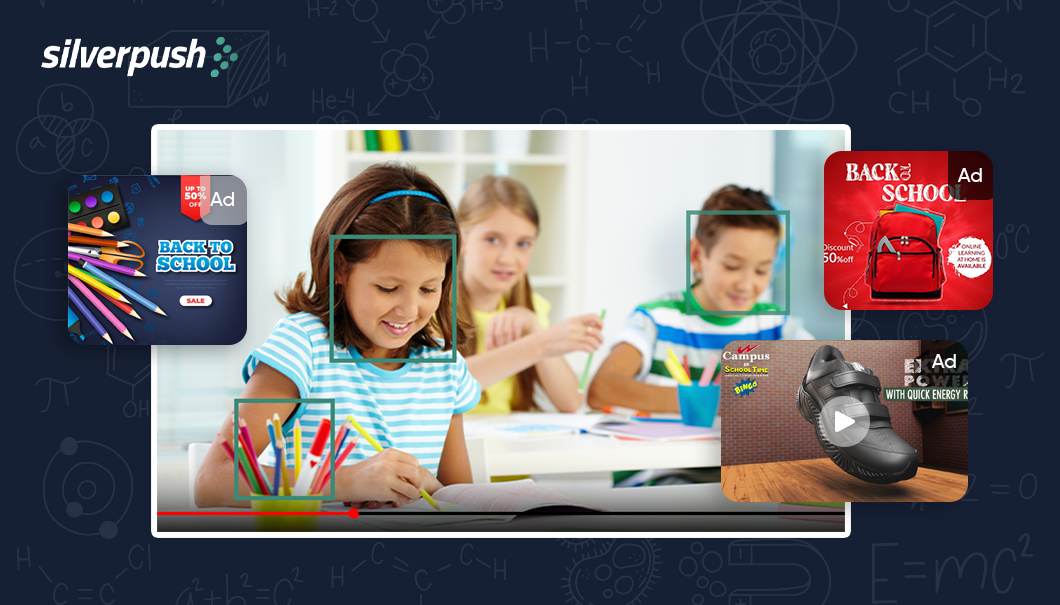
It’s time to secure an A+ in your back to school advertising! Captivate your audience and establish your brand as the go-to choice with contextual advertising.
As students in the United States prepare to say goodbye to their summer freedom and head back to school, parents are bracing themselves to say goodbye to their paycheck.
Returning to school after a refreshing and long summer break is one of the most important times of the year for both students and parents.
Whether it’s stocking up on stylish new school clothes to checking off every item on the school supply list, the retail industry recognizes the excitement and significance of this time of year, which requires loads of preparation.
As the school bells ring and summon students back to the back-to-school premises, it’s time for the brands to return as well.
Seizing the opportunity during this prime time, amidst the return of rival brands armed with improved targeting strategies and ads, how do you plan to connect with your targeted back-to-school shoppers precisely at the right moment, place, and with the perfect message? Look no further than Mirrors AI-powered contextual advertising to guide the way!
Who are the Back to School Shopping Audiences?
1. Parents
2. College Students
3. Teachers and Educators
4. School Administrators and Decision-Makers
5. Online Influencers and Bloggers
6. Early Childhood Education Centers
7. Adult Learners
Also read: Targeting Back-to-School Shoppers with Contextual Advertising
What are the Back to School Shopping Trends of 2023?
Some back-to-school trends advertisers should consider while creating this year’s seasonal marketing plan.
1. The increasing popularity of online shopping. More and more consumers are choosing to shop for back-to-school supplies online, as it is more convenient and often offers better deals.
2. Another trend is the growing importance of sustainability. More and more consumers are looking for sustainable options when shopping for back-to-school supplies. This means viewing sustainable ads or choosing products that are made from recycled materials or that are produced in an environmentally friendly way.
3. Shoppers are starting much earlier. Although the summer months still draw the heaviest activity, the back-to-school season now spans six months or even longer as many shoppers are:
-
- Buying early to avoid the pandemic-driven product supply issues of recent years.
- Taking advantage of sales events whenever they may occur.
- Trying to spread out their expenses over a longer period of time.
4. Parents have returned to physical stores. In-store shopping was expected to garner 49% of back-to-school sales in 2022 (versus 43% in 2021) when 42% of consumers told Deloitte they would only shop in physical locations (vs. 17% who would do it all online). That share of seasonal sales will likely increase again in 2023.
5. Finally, there is a growing trend towards personalization. More and more consumers are looking for back-to-school supplies that are personalized to their child’s interests. This means choosing products that feature their child’s favorite characters or sports teams.
Importance of Back to School Advertising for Brands
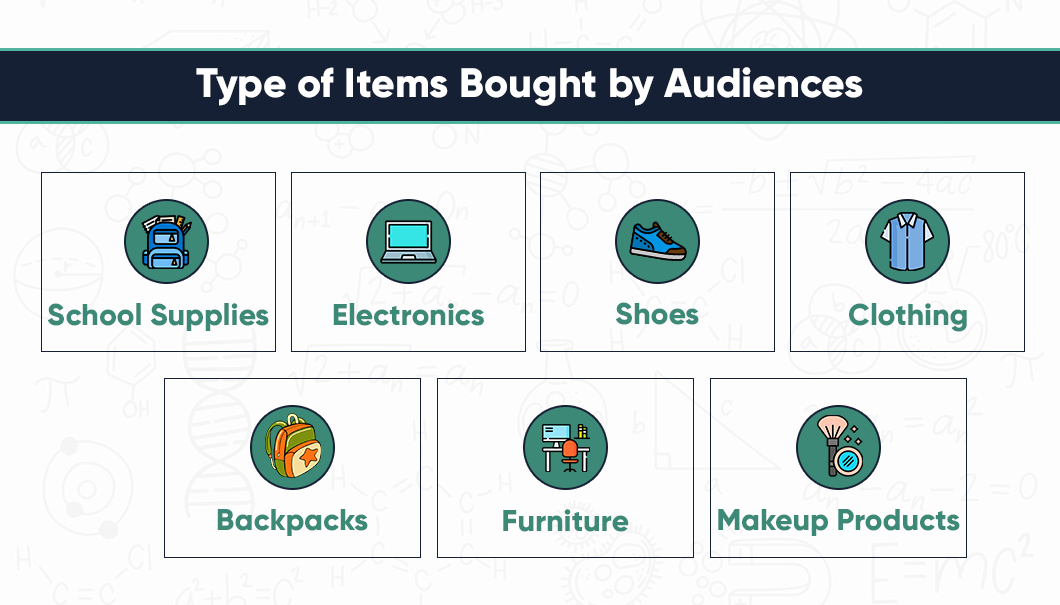
Back-to-school shoppers spent $168 more on school supplies in 2022, presenting a significant opportunity for the brand to expand reach and ROI. The compelling statistics will speak for themselves.
1. In 2022, the back-to-school season generated around $37 billion in sales in the United States.
2. The average family in the US spends $600 on back-to-school supplies.
3. 41% of shoppers planned an omni-shopping experience for desk/locker accessories, 35% in-store, and 25% online purchases.
4. 56% of back-to-school shoppers will start searching for supplies in early July and 88% of consumers are still waiting for their official school supply lists.
5. 8 in 10 consumers plan to use mid-July’s sales and events to shop for back-to-school supplies specifically.
Reach Where Your Targeted Back to School Shoppers Are
1. YouTube and Google are the top research platforms for shoppers before making purchases.
2. 25% of parents consult Facebook for BTS shopping inspiration.
3. US advertisers prioritized increased spending on social media (44%) and CTV/OTT (39%) for their back-to-school campaigns.
4. 62% of in-store purchases were consumables, compared to 10% online, with 28% of shoppers opting for an omnichannel shopping experience.
5. 41% of shoppers preferred an omni-shopping experience for desk/locker accessories, while 35% opted for in-store purchases and 25% chose online purchases.
Challenges of Using Traditional Methods for Back to School Advertising
1. Ad waste: Traditional advertising methods are exposed to a vast number of ads, making it difficult for advertisers to capture their attention and stand out from the competition.
2. Fragmented Audiences: Back-to-school shoppers can be found across various demographics and platforms, making it challenging for advertisers to reach them effectively using traditional methods. With the proliferation of digital channels and social media platforms, the audience is fragmented, and targeting specific segments becomes more complex.
3. Limited Targeting Options: Traditional advertising methods may offer limited targeting options compared to digital advertising. Advertisers may struggle to reach specific subsets of back-to-school shoppers based on their demographics, interests, and online behavior, resulting in wasted ad spend and reduced effectiveness.
4. Lack of Interactivity and Personalization: Traditional advertising methods typically lack interactivity and personalization, which are crucial for engaging back-to-school shoppers. Advertisers may struggle to create tailored and interactive experiences that resonate with their target audience, limiting their ability to establish a meaningful connection and drive conversions.
5. Difficulty in Message Customization: Traditional advertising methods often have limitations when it comes to customizing messages based on the unique needs and preferences of back-to-school shoppers. Advertisers may struggle to deliver personalized and relevant content that effectively communicates their value proposition.
Mirrors, Silverpush’s advanced hyper-contextual advertising technology, effectively targets and engages back-to-school shoppers. By intelligently identifying key contexts like celebrities, brands, texts, objects, and actions, Mirrors strategically places ads that deeply resonate with your desired audiences, reaching them at the right time and place with complete brand safety and suitability.

Final Words
The back-to-school season is an opportune time for brands to reach their targeted audiences at the time when they are most likely to engage with the ad and convert. Mirrors offers the solution you need to effectively engage with back-to-school shoppers. Simply fill out the form on the right, and our team will be in touch with you shortly to help you seize this valuable opportunity.
Cricket and Advertising: Winning Strategies for the 2023 World Cup
PUBLISH DATE: 12 May 2023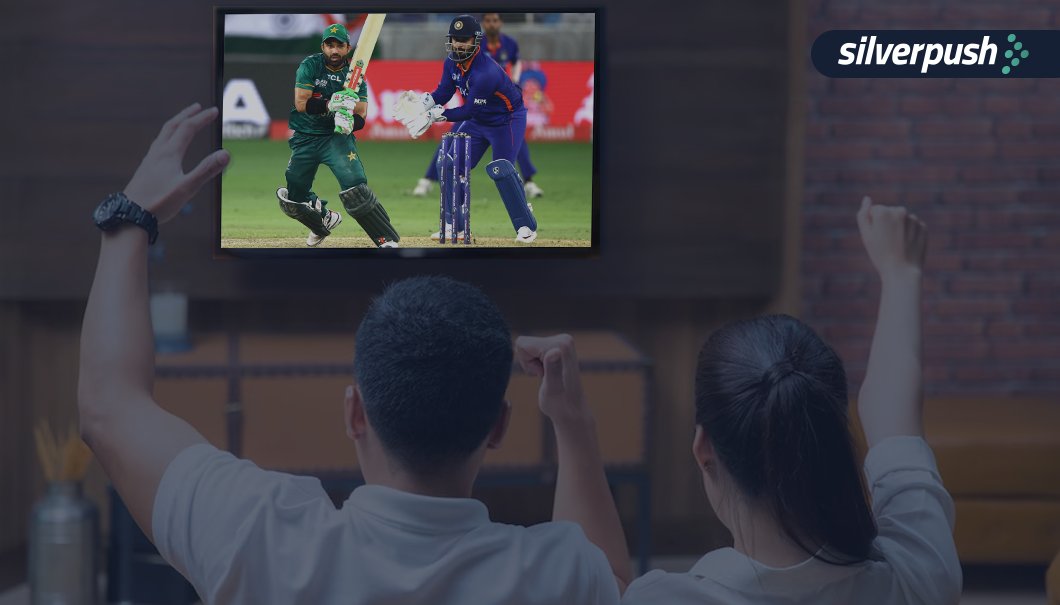
Cricket is Life. Everything else is just a game.
With 2.5 billion estimated followers, cricket is the second most popular sport around the world. The upcoming 2023, ICC Men’s Cricket world cup has already generated excitement among fans.
The ICC Men’s Cricket World Cup isn’t a tournament that viewers enjoy; rather, it is a festival for brands to establish a rock-solid awareness. Brands have a cut-throat competition to grab the attention of the dedicated audience.
In 2019, 94% of the sports AdEx was from cricket, highlighting the popularity of the sport among advertisers. The online streaming of the matches brought a new advertising field when the World Cup was first streamed on an OTT platform in 2015. Indian advertisers alone were expected to spend more than 400 million, and Star India expected TV and internet revenues to be around Rs 2,100 crores. Along with e-commerce, gaming, soft aerated drinks category, cellular phones, wires & cables, and perfumes & deodorants were some popular categories that were on top of TV advertising. Brands paid 20 lakhs onwards for 10-second ad spots, and the sponsorship package was for 40 crores onwards.
How Brands can Capitalize 2023 World Cup Opportunity?
The 13th 50-over ICC Men’s Cricket World Cup will take place in 2023, with India serving as the host nation. The quadrennial tournament is scheduled to take place in 2023, with India serving as the host nation for a record-breaking fourth time.
The format of the tournament will be round-robin before the knockout rounds, like the 2019 competition in England and Wales.
World Cup is the best time to tap into the audience’s mind and create a brand’s presence. Advertisers can use omnichannel advertising strategies to engage with the audience across all platforms and channels during the World Cup.
Some ways to capitalize are:
Traditional Methods Include
1. Sponsorship – Brands can become official sponsors of the tournament. A recurring brand recall can be easily created as brands will be promoted alongside the event branding.
2. Television Advertising – There is a drop in this field of advertising but millions of people are still glued to tv screens when there is a match, especially in remote areas. By creating strong tv ads brands can have the ever-lasting memory for the audience.
The “Mauka Mauka” ad campaign created a huge brand recall in 2015 and 2019 irrespective of the results. The notable point is when the first advertisement appeared on YouTube in 2015. it received more than a million organic views in the first 12 hours of being live.
Digital Methods Include
1. Video Advertising: People eagerly wait to grab any information during a cricket match. From watching a live cricket match on the OTT platform to watching highlights on YouTube, videos get the center of attention. Advertisers can leverage this attention by using different ad formats available on YouTube.
2. Social Media Advertising: During cricket tournaments, social media platforms, Instagram, Facebook, Twitter, and LinkedIn are flooded with the updates. These platforms offer various advertising opportunities which an advertiser can utilize to benefit themselves. Based on the demographics, advertisers can target specific audiences.
3. CTV Advertising: A huge set of audience is shifting from traditional Tv streaming to connected devices. This is an advantage for advertisers as CTV allows granular targeting. This means with the right message, advertisers can reach their target audience exactly where they are.
Another interesting advertising element present for the 2023 World Cup is contextual targeting. In 2019, the news of the phase-out of third-party cookies was spread. This led advertisers to look for an alternative. But during 2019, contextual advertising was not in the picture. However, with time this form of advertising proved to be a beneficial alternative. Combining the power of contextual advertising and the World Cup together can bring outstanding results.
Mirrors is a flagship product of Silverpush which is helping brands reach their target audience on different channels in the most contextual way possible.
How Brands can Leverage the AI-Powered Technology, Mirrors?
Studies have proven that 63% of users prefer relevant ads and it makes them engage with the brand. This also results in higher ROIs and ROAS.
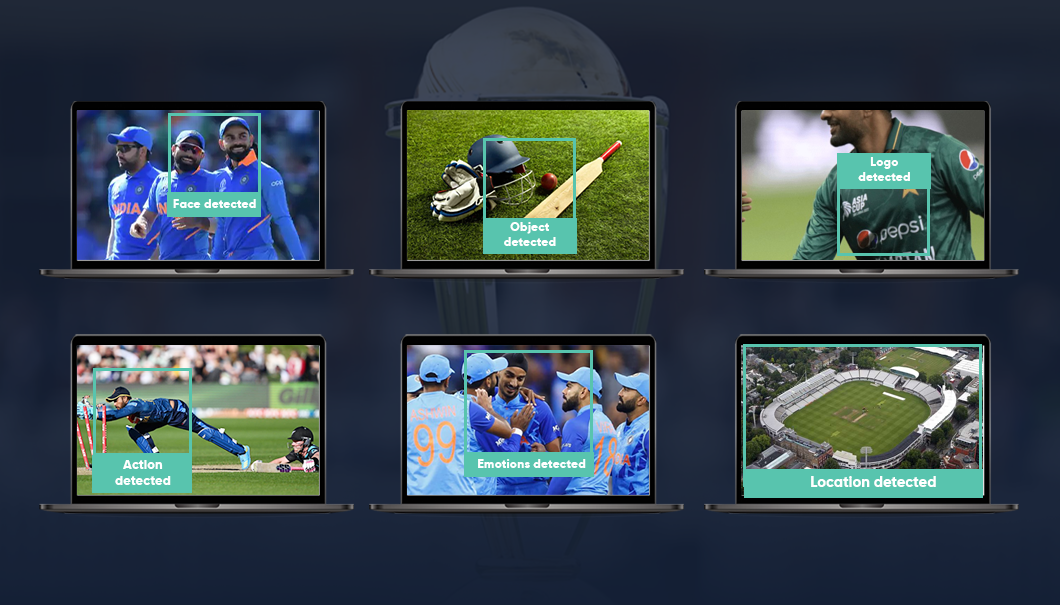
To place relevant the human-augmented technology work on six triggers, renowned faces, brands logos, action, objects, emotions, and locations.
With contextual advertising, advertisers can easily engage the audience on each platform without interrupting their viewing experience.
Mirrors for YouTube
People are glued to the screen when it’s time for the world cup. Men’s CWC 2019 live coverage crossed a cumulative average audience of 1.6 billion viewers on a global scale. The average watched time per unique viewer was 42% higher than in 2015. This leaves advertisers with the hope that it will be much higher for 2023.
To leverage the attention of the large audience the human-augmented technology, Mirrors is trained to place ads in the most relevant manner. With the help of computer vision, the AI will recognize the in-video triggers and will place the most suitable ad that aligns with the content consumed by the user.
Mirrors for Facebook
Mirrors similarly work for Facebook. But while extracting insights based on visual triggers it also dives into the context of the text.
Keyword-based targeting reduces the reach of a campaign by blocking the content based on keywords, contextual targeting understands the context of the word being used. This enhances brand safety as well as increases the ad placement opportunity.
Final Words
The World Cup is a complete package for advertisers to promote. Brands have a fantastic chance to expand their awareness and connect with a global audience during the World Cup. With the popularity of cricket at an all-time high, advertisers must take advantage of this trend and develop effective marketing campaigns that connect with their target market.
We can claim that brands could expect improved ROIs and reach during 2023 ICC Men’s Cricket World Cup by harnessing the power of contextual advertising.
The Demise of Third-Party Cookies: Can AI Advertising Fill the Void?
PUBLISH DATE: 15 March 2023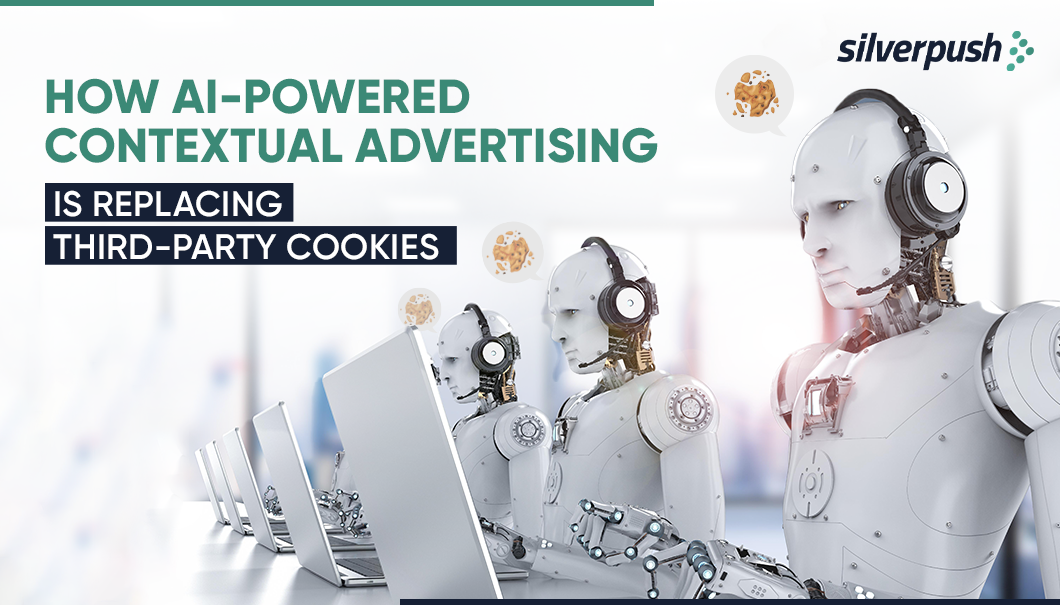
As third-party cookies crumble, AI advertising is gearing up for its time in the spotlight – get ready for the rise of the machines in the ad tech industry!
The importance of third-party cookies can be well understood by digital marketers who rely on these small pieces of information to serve personalized ads to their audiences.
The usage of user data without their consent or knowledge has sparked significant debates surrounding consumer privacy, with users, legislators, and companies all expressing concerns about the potential impact on individual confidentiality.
Although cookies have been valuable for advertisers and marketers, their usage is now being closely examined as users demand more control over their online data, and companies face increasing pressure to prioritize consumer privacy. Major web browsers like Mozilla Firefox and Safari have already banned third-party cookies, and Google Chrome will soon follow suit.
To navigate the post-cookie world, advertisers will need to explore alternative options like Artificial Intelligence (AI), which is likely to replace cookies. AI-powered contextual advertising has emerged as a powerful tool for innovation, with companies using it for management, robotics, and marketing.
What Challenges are Faced by Marketers Due to Third-Party Cookies?
Ad tech companies often use a technique called fingerprinting to track users and deliver personalized ads. Fingerprinting relies on third-party cookies to generate user-specific browser ID tags.
When a user accesses a website with a cookie-based ad, a tracking pixel embedded in the ad collects the user’s browser tag and sends it to the advertiser’s server. Ad tech companies then use this information to develop user profiles and track browsing history, purchases, and other personal information.
However, users often have little knowledge of what personal information is collected and have limited control over preventing unwanted data collection unless they manually disable cookies on their browsers.
Eliminating the Use of 3rd Party Cookies
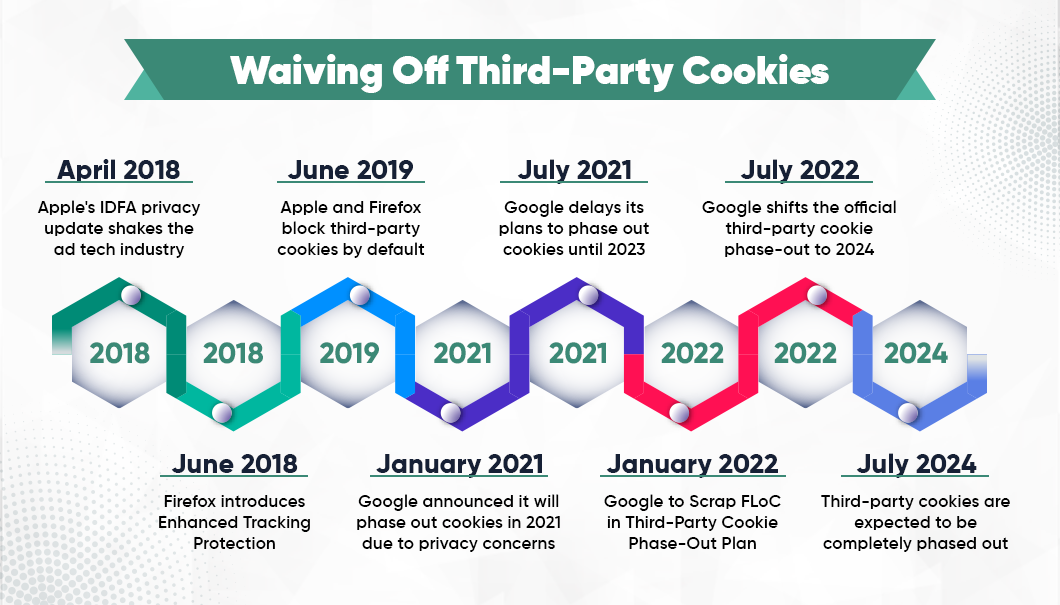
As privacy concerns grow, more companies are opting out of using third-party cookies. Major web browsers like Safari and Firefox have already blocked cross-tracking third-party cookies, and Google plans to phase them out on Chrome by 2024 to address user demands for greater privacy, transparency, choice, and control over their data.
Advertisers, who rely heavily on third-party cookies for data collection, will be significantly impacted by this change and must find new ways to access similar sets of data.
The most comprehensive data regulation to date is the General Data Protection Regulation (GDPR), which came into effect in 2018 within the European Union. It has set a high bar for data protection standards globally, as it emphasizes the importance of user consent and data transparency, putting greater control over personal data in the hands of users.
The Future of AI Advertising: Moving Beyond Third-Party Cookies
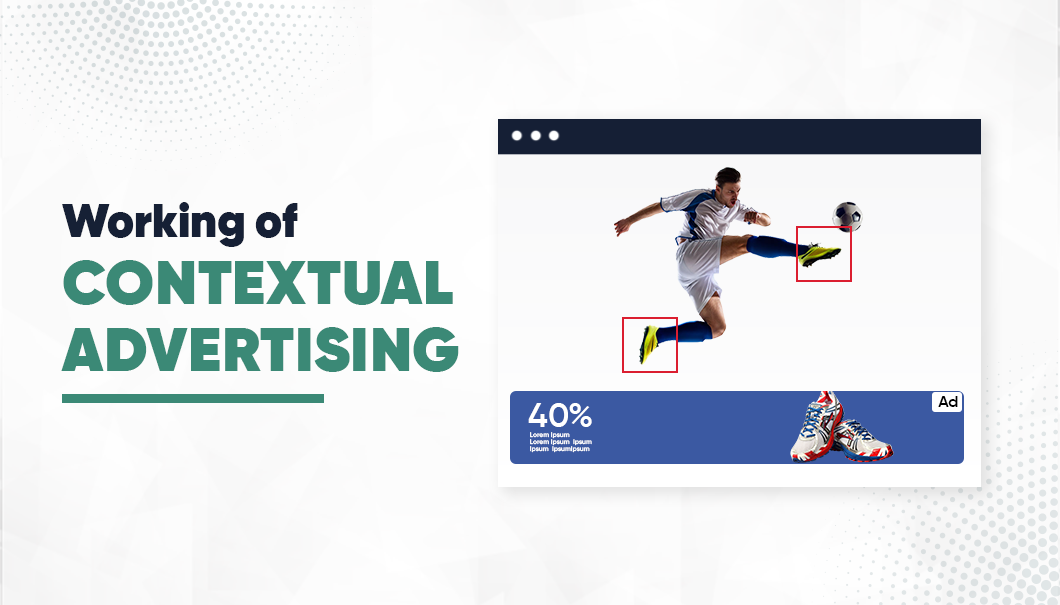
With the phasing out of third-party tracking cookies, advertising agencies are turning to contextual advertising as a strategy for targeting users based on their online experience categories, rather than behavioral advertising. Contextual targeting is being seen as a brand-safe, future-proof, and successful cookieless targeting option.
According to market data, the global contextual advertising market is predicted to reach $376.2 Billion by 2027, indicating the increasing popularity of this strategy.
Companies worldwide are redirecting their marketing resources toward developing a strong contextual strategy to adapt to the changing landscape of digital advertising.
Statistics that highlight the importance of contextual advertising:
1. Context is so powerful that 49% of brand marketers are looking to contextual advertising to replace cookies.
2. 79% of consumers are more comfortable seeing Contextual than behavioral ads.
3. Between 2020 and 2027, contextual advertising spending is expected to grow 13.3 percent annually.
4. 49% of US marketers surveyed are using contextual marketing today.
5. In the UK, 32% of marketers use contextual marketing, while 36% use demographic targeting.
Silverpush Leads the Way in AI-Powered Contextual Advertising for a Cookieless Future
As the digital advertising industry transitions to a cookieless future, contextual targeting is emerging as a powerful solution for advertisers looking to engage with their target audience.
Silverpush, one of the leading ad tech companies in the world recognized the limitations of third-party cookies years ago and developed their AI-Powered solution, Mirrors, which has been providing contextual advertising solutions on platforms like YouTube, OpenWeb, Meta, and CTV since 2012.
Mirrors use privacy-safe and contextual targeting solutions to deliver personalized ads to the target audience without relying on their data.
What Makes Mirrors Unique?

Mirrors’ AI-powered technology identifies ley contexts like celebrities, brands, objects, and other factors for more precise targeting. Its unique custom identifying capabilities ensure that reach is not duplicated, and a unified approach is used for content-aligned ad placement, brand safety, and custom brand suitability.
The ads are placed in a brand-safe environment and are relevant to the brand, ensuring a positive and effective advertising experience for both the advertiser and the audience.
If you’re interested in learning more about how Silverpush can help you prepare for the cookieless future and advertise successfully, fill out the available form on the right and our team will reach out to you.
Ad-Tech Industry’s Competition, Productivity, and Regulation
PUBLISH DATE: 29 July 2022
The rise of the advertising technology industry is frequently seen as a historic moment in advertising history. Ad-tech delivers distinct benefits to marketers and consumers by algorithmically personalizing ads based on individual actions and interests.
Despite these potential benefits, the fast-paced nature of this sector has resulted in possibly anti-competitive behavior. These have prepared the way for revolutionary reforms, such as the European Union’s recent Digital Services Act and Digital Markets Act.
To a great part, anti-competitive behavior in the ad-tech business stems from the industry’s supply chain’s complexity, along with the “winner takes it all” mentality of certain firms that exploit vertical and horizontal integration.
Several companies in the business, for example, are vertically integrated ad-tech suppliers that also provide relevant consumer-facing services. They can use foreclosure methods or horizontal collaboration to hurt the competition.
Furthermore, the expanding usage of “attention markets” in the digital economy shows the erroneous belief that advertising is customers and that users’ attention is the commodity sold to advertisers. This has the potential to hurt customers since their ideas are being targeted by computational techniques. These ideas may be adjusted using attention-focused criteria to successfully convert visitors to buyers.
This algorithmic technique results in information asymmetry between marketers, publishers, and consumers, with people ignorant of how their personal data is being utilized to manipulate their judgments, choices, and views. The collection of such data by enterprises in this market also raises major entry hurdles, allowing big tech corporations to capitalize on their first-mover advantage by acquiring stakeholders and developing 360-degree consumer technology.
New entrants may find it difficult to compete with assets such as an existing user base, especially if restrictions such as a lack of data and user interoperability, as well as data portability, exist. These are the consequences of network effects, which arise when the number of other customers who use a product or service influences the demands for that product or service. The multifaceted character of digital marketplaces exacerbates such damages.
To conclude, the goal of regulatory intervention is to increase market efficiency while protecting stakeholders such as consumers. This, in conjunction with the core of competition law, which states that the goal of competition law is to safeguard the competition rather than the competitor, allows one to rethink the balancing act of competition, efficiency, and regulation in the ad-tech business.
Role of Artificial Intelligence in Digital Advertising
PUBLISH DATE: 08 July 2022
The world has shifted more toward technological development in recent years, and the advent of cutting-edge technology in the digital sphere has an impact on every industry worldwide. This has led to significant advancements in AI and other machine learning techniques, which have a significant impact on digital advertising.
The Insight Partners’ report projects that by 2028, the global market for artificial intelligence in the marketing industry would be worth US$ 107,535.57 million, expanding at a 31.6 percent compound yearly growth rate (CAGR). But AI is also changing the digital advertising scene, with chatbots and virtual assistants, among other things, as well as content creation and improvements to the user experience.
Machines can now examine data and carry out cognitive activities thanks to artificial intelligence. It analyzes and thinks like a human to make pertinent decisions, accelerating and simplifying the planning and execution process. The majority of people could argue that it will replace people, however AI really benefits people by making the process more efficient. AI automates the entire tedious procedure after the requirements are established and the inputs are provided. This makes sure that humans are not required to perform any laborious tasks.
Additional advantages of AI include those listed below.
Enhanced ROI and Productivity: Since operations are automated based on instructions, using AI in digital marketing increases productivity. AI can also determine which kind of content works best and aid with content selection. The proper material consequently reaches the right audience, enhancing ROI.
Improves the User Experience: AI uses machine learning (ML) to gain a deeper understanding of its users. As a result, viewers are kept interested and engaged by displaying content tailor-made to their tastes. Positive user experiences increase the likelihood of people purchasing goods or services.
Chatbots with AI: Using pre-programmed sentences and expressions, a chatbot is a type of artificial intelligence software that can mimic a human conversation. Chatbots are tremendously helpful for automating numerous tasks, responding to frequent client inquiries, and even closing deals.
Digital advertising will see an increase in its use in the upcoming years due to AI’s rapid expansion. Many digital advertising companies are developing AI to meet these expectations. AI will give businesses and consumers a competitive edge in the digital age.
Silverpush Wins Multiple Awards at MMA Smarties MENA 2020
PUBLISH DATE: 30 March 2021Silverpush has won 4 awards in a row at MMA Smarties MENA 2020.
Silverpush has won a Gold and 3 Silver awards across multiple categories. It has won Gold for Mobile Gaming, Gamification & E-Sports category, and a Silver for each of the following three categories – Lead Generation, Direct Response, Conversions; Machine Learning & AI; and Innovation.
MMA Smarties MENA awards honor the most effective modern marketing efforts across the Middle East and North Africa region. Smarties awards recognize leaders, brands, agencies, and tech providers that make use of technology to pioneer new approaches in modern marketing. MMA Smarties awards are held annually to honor outstanding innovation and creativity resulting in significant business impact.
Silverpush was honored with Gold for its Euphoria Moments campaign for Rakbank. To bring Barca fans closer to their club, Rakbank launched the FC Barcelona credit card. Rakbank wanted to reach the target audience for its new credit card by tapping into fans’ emotions, passion and pride. For this, it leveraged Silverpush’s real-time moment marketing platform – Parallels. Silverpush identified game’s euphoria moments such as Messi scores, Barca scores and Barca wins, and connected with the fans during these moments by delivering them relevant brand messages. These messages persuaded fans to join the winning team by applying for the card. The campaign delivered highly impressive results. There was 57% increase in leads for the card. Silverpush’s real-time sports sync technology enabled Rakbank to reach Barca fans during the moments they were most likely to engage.
Silverpush won a Silver for the Lipton Stay at Home campaign under the innovation category. Lipton wanted to run an ad campaign on YouTube with the idea of encouraging people to spend time with their loved ones and increasing mental well-being awareness during the pandemic. For this, Lipton leveraged Silverpush’s Mirrors – the world’s first AI-powered in-video context detection platform. Mirrors detected in-video contexts in YouTube videos – text such as anxiety related content, activities such as exercise; objects such as a glass of juice; etc. – and served contextually relevant ads. The campaign drove massive reach and brand awareness, along with a significant increase in market penetration.
Silverpush is revolutionizing the advertising industry with its technological innovations. Its ad tech solutions are helping brands to strongly connect with consumers and boost brand awareness, conversions and sales.















